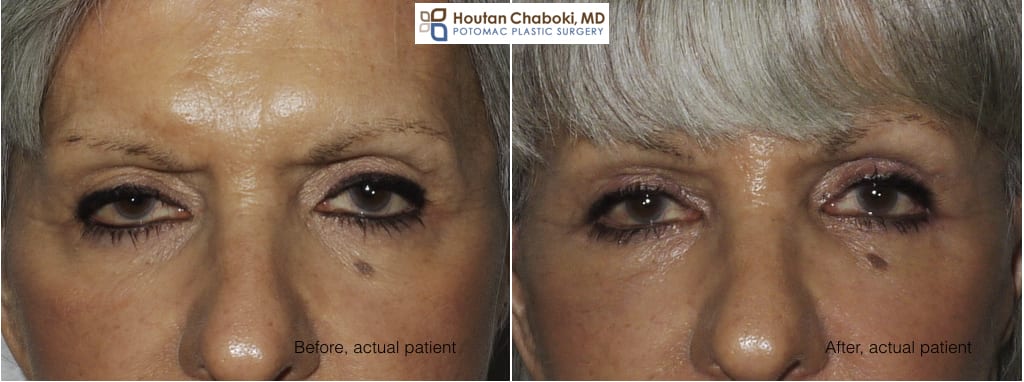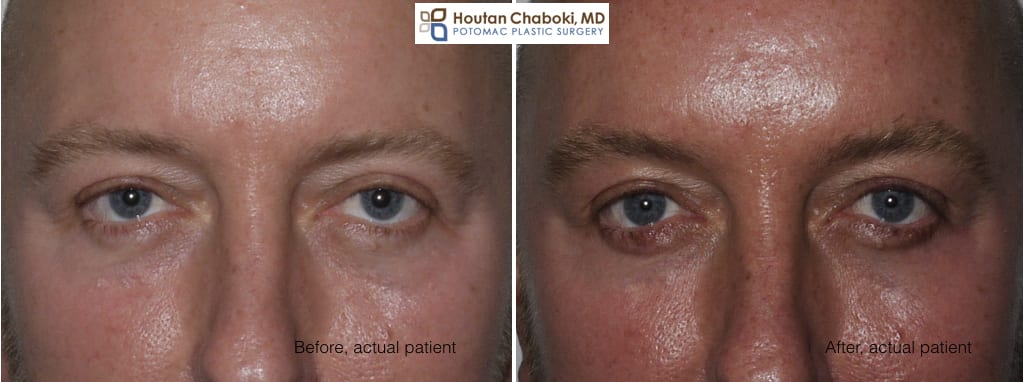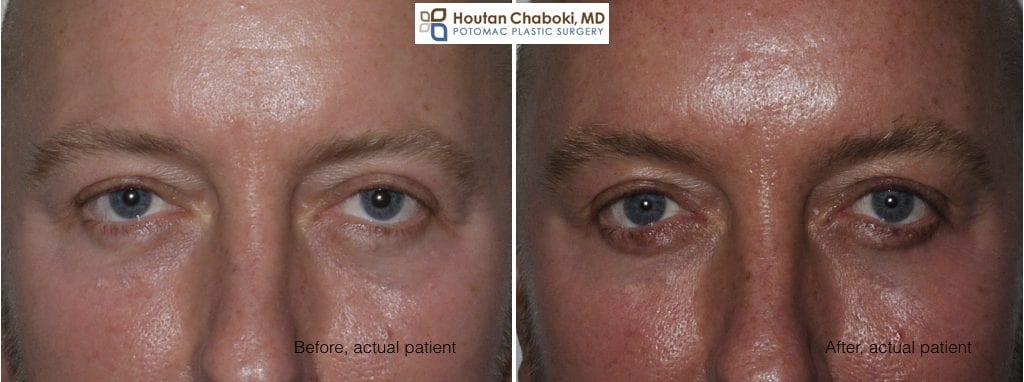Puffy lower eyelids and dark circles are common reasons to see a plastic surgeon. Some are born with excess fat or skin, while everyone develops cosmetic changes from natural aging. We’ve reviewed some options to improve the lower eyelid region, including nonsurgical filler injections for eye bags. Lower eyelid surgery, however, remains the standard for permanent change of a puffy eyelid.
There are two main approaches to lower eyelid plastic surgery based on the location of the incision on the lower eyelid, outside or inside.
External incision (subciliary approach)

Before and after lower blepharoplasty (eyelid surgery) via an external, subciliary approach. Patient also had revision facelift, neck lift, brow lift, chin augmentation, and fat transfer.
An incision is made just under the eyelashes along the length of the lower eyelid, with a variable extension beyond the side of the eye. This external incision, also called subciliary approach, allows plastic surgeons more access and ability to modify all the tissues of the eyes. Fat can be reduced and/or repositioned, muscle can be lifted and tightened, and excess skin and wrinkles can be reduced.
Plastic surgeons often will use stitches with this type of lower eyelid blepharoplasty that dissolve gradually over several days. Even though there is an external scar, it fades and often not noticeable with time. As with all open approaches in plastic surgery, there tends to be more bruising and swelling. However, only this method of eyelid surgery method can reduce excess skin.
A slight modification of the subciliary lower blepharoplasty is called a “pinch blepharoplasty“. A conservative amount of excess skin is pinched and trimmed under the eyelashes. Pinch blepharoplasty does not reduce eye fat, just excess skin that contributes to wrinkles. This method can be performed in the office via local anesthesia, either alone or after the initial blepharoplasty as needed.
An external incision used to be the only method for lower blepharoplasty until medical advances in cosmetic and reconstructive plastic surgery introduced alternative methods, such as the internal incision.
Internal incision (transconjunctival approach)

Before and after lower blepharoplasty (eyelid surgery) via an internal, transconjuctival approach. Patient also had upper eyelid surgery and Botox® injections.
An internal incision has been used for years, but is still a relatively newer technique as compared to the external incision. Transconjunctival blepharoplasty is a more advanced method that some plastic surgeons utilize to rejuvenate the eyes. An incision is made on the inner, pink surface of the lower eyelid. Plastic surgeons can modify eye fat with this approach, but can’t lift or reduce loose skin. Stitches that dissolve are always used with the internal incision and are typically not noticeable by patients.
Other than avoiding an external scar, there typically is less bruising and swelling as compared to the external approach. Patients with eye bags with preexisting good skin and muscle tone can consider this method of lower eyelid surgery.
What is best method lower blepharoplasty?
There isn’t a “best” method for lower blepharoplasty. Patients with lower eye bags from excess fat alone, more common in younger patients, may be better candidates for transconjunctival blepharoplasty. Patients who are older and also considering facelift surgery for loose skin might be better candidates for subciliary blepharoplasty.
The best plastic surgeons will utilize a variety of techniques to enhance the eyes, while promoting safe and natural results. The decision to how to perform lower eyelid surgery is based on multiple factors, including a patient’s specific eyelid anatomy and personal preferences.
Questions about lower eyelid surgery? Share your thoughts below.


Does infraorbital external incision for orbital tiranium implant will boost to have eyebag
Thank you for reading the blog!
External incisions in lower eyelid surgery generally are to reduce eye bags. We often use internal incisions to avoid an external scar during lower blepharoplasty.
Best,
Dr. Chaboki
Dear Houtan,
what kind of suture do you use for approximation of conjunctival incision.
Thanks for your reply
Thank you for reading the blog. Typically, sutures used in cosmetic eyelid surgery, such as transconjunctival, dissolve after cosmetic surgery.
Best,
Dr. Chaboki
I had eye surgery in the corner of my eye I have a bad scar at the outer corners can I have some did to fix this?
Thank you for reading the blog!
Scar will occur after any plastic surgery. Many scars gradually fade with time. Some scars can be treated with injections. Read more about scar injections on our website.
Best,